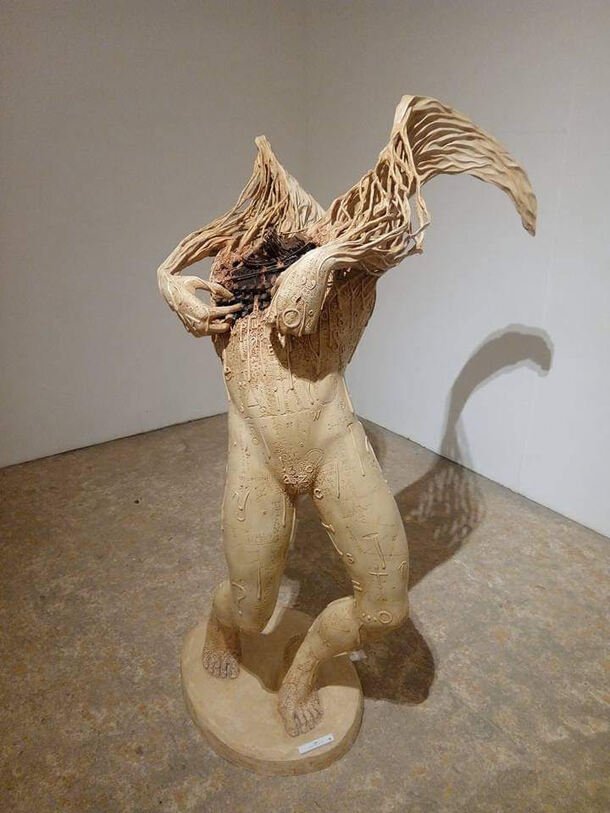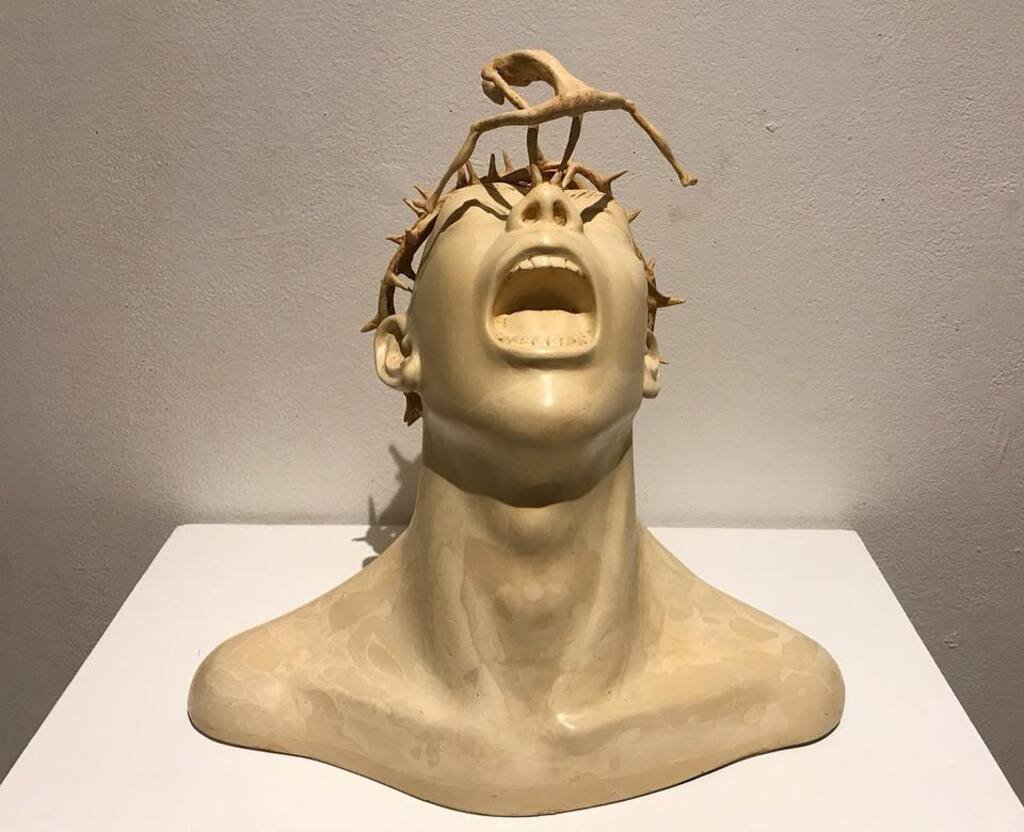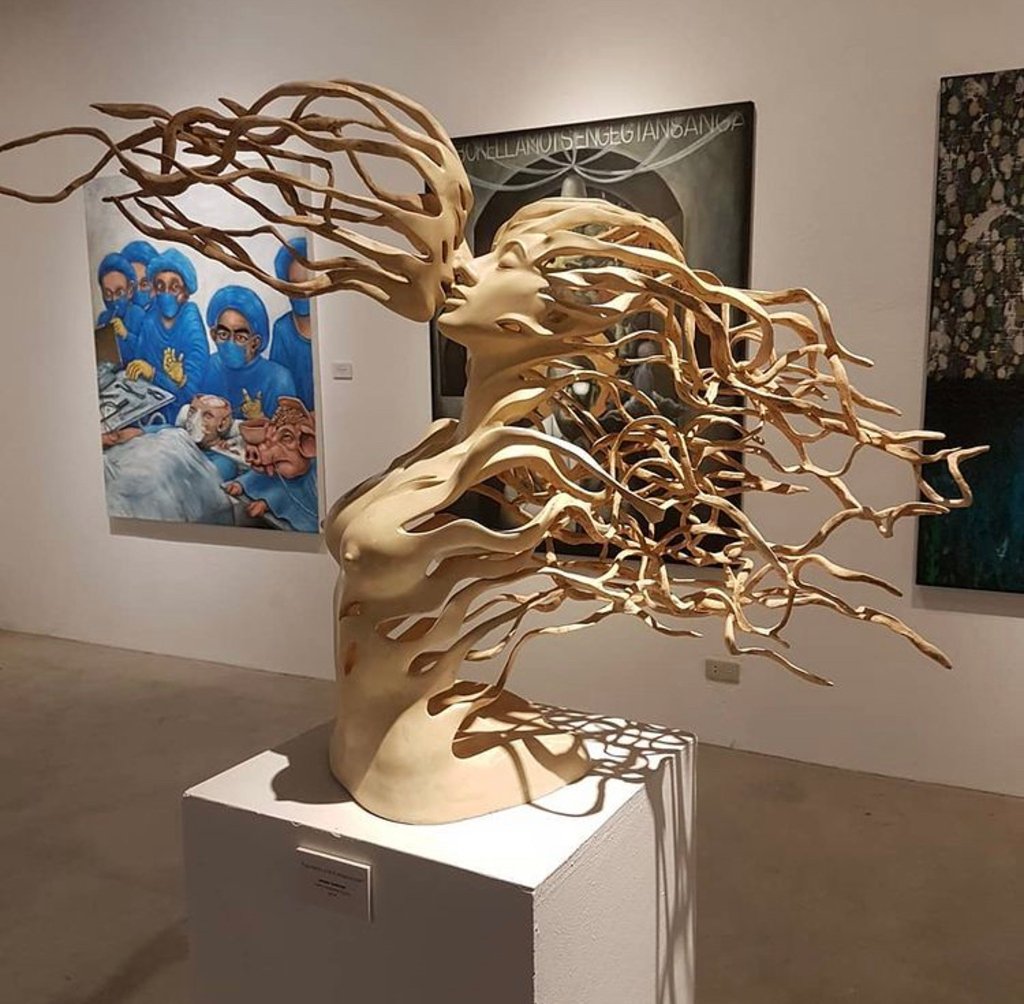Introduction and Interview Gabrielle de la Cruz
Images Jerson Samson
Serendipity is defined as the occurrence and development of events by chance in a beneficial way. In most cases, it can be read as a happy little accident, one where someone finds value or meaning that was not initially sought.
Such is the case of and with an artwork that I recently stumbled upon. Months ago, I was walking through a museum and saw a sculpture of a winged creature with a typewriter buried in its chest. I was naturally drawn to it as someone who has dreamt of being a writer as early as ten. The artwork had words and phrases carved all over its body, with its arms stretched towards its chest so that its fingers reach the typewriter keys. After observing it for quite a while, I looked down and read the sculpture’s label. “Salita, Jerson Samson, 2018. Hand-molded epoxy.”


Its name could not be any more fitting, as the piece finds its own way to speak to the beholder despite being incapable of sound and movement. To me, it read as a translation of many things — a baring of one’s soul, the ups and downs of being a messenger, and even the reception of words that cut and bleed. I then wondered how such a provoking artwork was made and what the artist could have felt like to create it.
Months after that encounter, I mustered up the courage to contact the artist. I opened the chat by describing how moved I was by Salita, only for him to reveal that the piece was actually created “by accident.” This then led to far more interesting discussions about his craft, which eventually paved the way for this exclusive interview with Kanto.
Below is our conversation:


Hi Jerson! What have you created today?
I am currently working on some paintings. I don’t think there is ever a day that I don’t do art.
Please share with us your artistic beginnings.
I’m not so sure if I can be called a late bloomer. It was in elementary when I started to draw. Every Saturday, I would watch cartoons and use the characters as my subjects. Superman, Batman, and The Flash were some of the prominent characters then. Somehow I stopped given all the distractions growing up and it was only in my third year of high school when my interest in art resurfaced.
I then met Mr. Solano Cruz, an art workshop teacher from Manila and a good friend of Filipino painter Fernando Sena. I decided to take a summer art workshop under his mentorship. That was also the time when I became more familiar with techniques and materials. This was when I realized that this is the field where I would excel and was even more eager to pursue fine arts once I graduate high school.
From there, I started joining art competitions and going to and from places. I was consistently inspired to win the prize money as I would use this to buy and slowly complete all the art materials that I always wanted to have. Through hard work, determination, and perhaps with the help of luck, I actually won most of the time.
College was pretty much the same. The competitions were endless and I literally had no complaints as I had the money for art materials and I was able to do what I love.
In 1993, I took the Talent Determination Test at the University of the Philippines Diliman and failed. I wasn’t able to finish given my meticulousness. I decided to retake the exam a year after and given my familiarity with the process, I passed. My sibling and I are both 1994 TDT passers. I even gave them a few tips so they don’t make the same mistakes I did.
After this, it was all basically contests and art shows. I would even say that competitions brought life to my artistic career. Opportunities arrived every once in a while until I was eventually able to participate in national and international art shows. I don’t even remember how many one-man shows I did for painting. Probably 14-15?


What inspired your transition from painting to sculpting?
It was in 2013 when I decided to try sculpting. I recalled how I actually excelled in my sculpting class in college and how our professor used to applaud me for my work. I asked myself to give it a try, rest assured in the thought that I am capable. Figurative sculptures were actually my initial plans. I was attracted to romanticist sculptures then. I like how they appear to be neat, smooth, soft, detailed, dramatic, and visually refreshing. Those were my very first sculptural inspirations.
The use of Christian and religious imagery to depict states of anger, distress, and fear is a recurring theme in your sculptures. Can you tell us more about this approach? How does this method of expression speak of your convictions as an artist and as an individual?
I was born a Catholic and have a devoted family, so I was exposed to religious images as early as I can remember. Growing up was however different. My realizations and experiences as an adult caused a shift in perspective, leading me to become an atheist.
My artworks are screams of freedom. Through these, I am able to express who I am and what I believe in. The images and themes that I use are personal and artistic reflections of all my experiences.


Let’s talk about the culprit behind this interview, Salita. May I know what this particular piece means to you?
I never actually planned on creating Salita. There was this old typewriter lying around our house that my mother wanted me to throw away. It was actually already in the garbage when I saw it. I suddenly thought of likening the typewriter to a person.
I then saw an image of someone who is slowly forming themselves out of typed letters, someone with words etched into their chest.
I would say that Salita is my self-portrait. All the life lessons that form my entire being are carved into my heart. I use messages as my primary defense in life. My goal is to freely express my truth and not be bound by anything.
I intentionally sculpted Salita with no head or face. Because as an artist and a human being, I believe that I am still a work in progress. I am still slowly writing my story. It is how Salita is perceived to be unfinished that makes it interesting. How it is incomplete in form makes it complete in meaning.


Can you tell us more about your process? How does inspiration strike? How long does it usually take you to create a sculpture?
Inspiration strikes anytime and anywhere. My ideas are free-flowing, which is why I feel happy when I take on a new project. There’s always excitement about the outcome.
All of my works are hand molds. Mano-mano. I usually start by creating armature from wires and wrapping them with masking tape. You can say that my process is similar to that of paper mache, except I use tape. I find that tape is easier to manipulate and it assists in the creation of a clean canvas.
From there, I would build up epoxy. My pieces are usually large, so one would typically take about a month or two.
What challenges do you usually encounter during the sculpting process? How do you manage to get through them?
Most of the time, there would be inadequate or excessive proportions, so I would either need to cut down or add more. Epoxy can get as hard as stone, so reducing or adding can be a challenge. Sometimes I get hit with ideas during the process, so I am forced to make more adjustments to the composition. My works are huge and heavy, so weight can also be an issue.


Why do you use epoxy in particular? Do you see yourself working exclusively with this material or do you intend to explore other mediums?
Epoxy is versatile. It is durable and capable of withstanding outdoors. I would say that this is fitting for more as someone who pays attention to the smallest of details. With epoxy, I am able to perform anything and everything I can think of. It is not limiting. I am able to play around with each piece because of the beauty of this medium.
I plan to explore this medium more by mixing it with stainless steel. I am currently studying welding. Maybe in my next show, I can produce an epoxy and steel sculpture or even a pure steel sculpture.


How have audiences responded to your work so far? What observations and questions do you usually hear?
A lot of people have asked me if I do casting, probably because of how popular resin is at the moment. What surprises me is that when I say no, I usually hear a lot of regrets or dismay. It will then be revealed that they asked because of “the opportunity to duplicate or create copies” of each of my works.
My idea is that I want each piece to be unique. I want all my artworks to make people think about why and how I did them. I want my art to showcase how complicated my process is. I want to stick to the old-school, handmade method.
Of course, I do hear a lot of positive comments. Most of the ones who have seen my work express how in awe they are of how epoxy can produce complicated and detailed images. This makes the difficulty of the sculpting process worth it.


What are your thoughts on the Philippine art sculpture scene at the moment? Where do you think it’s headed? What do you wish to see?
The community of Filipino sculptors is relatively smaller than that of Filipino painters. I would say that sculpting is still a juvenile craft in the Philippines, especially compared to other countries. There are so many exciting and new possibilities that can come out of the Philippine sculpture scene.
I look forward to the day when we have our own foundry that can cast giant metallic pieces. I really hope we can have one. I would love to be a part of it and would be honored to contribute to its further development.


What other things keep you busy? What are your hobbies and interests?
I’m a martial arts enthusiast. I am a Brazilin Jiu Jitsu blue belter. I also compete in this field and have tried boxing and MMA fighting. I love the challenge, despite the physical pain that comes with it. I am usually willing to try all these given my constant pursuit of growth across all aspects.
I like to cook. If I chance upon an interesting recipe online or discover a new dish in a restaurant, I experiment at home and try to recreate it. Being a Filipino, I also sing at karaokes occasionally. •
Gabrielle de la Cruz started writing about architecture and design in 2019. She previously wrote for BluPrint magazine and was trained under the leadership of then editor-in-chief Judith Torres and previous creative director Patrick Kasingsing. Read more of her work here and follow her on Instagram @gabbie.delacruz.


3 Responses
Maraming salamat po sa pagkakataon at oras na binigay nyo para akoy maka usap at ibahagi ang kwento ng buhay at sining ko..salamat Po Kanto.com.ph at sa bumubuo nito, salamat gabbie delacruz♥️
Gustong gusto ko nakakabasa ng mga artist tungkol sa mga gawa nila ❤ Mas lalo akong nahuhumaling sakanila. sana mas dumami pa ang ganitong content.